In the competitive landscape of search engine optimization, getting your new content or updated pages noticed by Google and other search engines quickly is a critical advantage. Waiting for crawlers to naturally discover your changes can mean lost traffic and missed opportunities. This is precisely the problem a free pinging service is designed to solve. By sending a small notification, or "ping," to various search engines and web directories, you can signal that your website has fresh content ready for indexing. This simple action can significantly accelerate the discovery process, helping your content rank faster.
This guide cuts straight to the chase, providing a detailed breakdown of the best free pinging service platforms available today. We've moved beyond simple lists to offer a comprehensive resource for SEO specialists, marketers, and web developers. Each entry includes an honest assessment of its features, practical use-case scenarios, and a clear look at its limitations.
You will find direct links, screenshots, and concise analyses to help you select the right tool for your specific needs, whether you're a blogger publishing a new post, an e-commerce manager updating product pages, or a developer testing site accessibility. Let's explore the tools that can give your content the indexing boost it needs.
IndexPilot stands as a premier choice in the realm of indexing automation, moving beyond a simple, manual free pinging service to offer a comprehensive, automated solution. It's engineered for marketing teams, agencies, and businesses that require immediate visibility for new and updated content on Google and Bing. The platform's core strength lies in its real-time sitemap monitoring paired with the innovative IndexNow protocol. This combination ensures that as soon as you publish or update a page, IndexPilot automatically pings the search engines, effectively eliminating the frustrating delays common with manual submission methods.
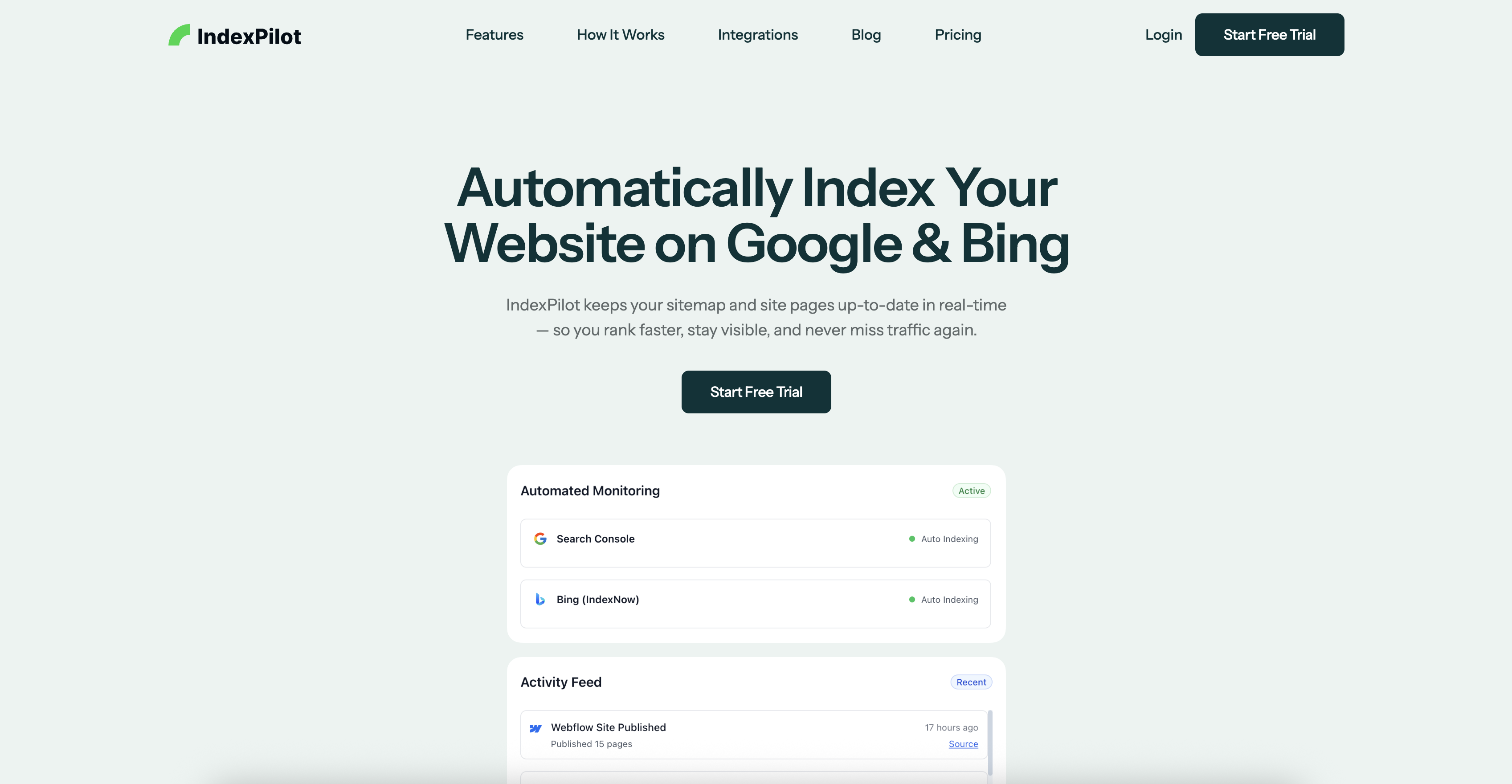
The platform distinguishes itself with a sophisticated yet intuitive dashboard that provides live insights into your site's indexing status. This isn't just about sending a ping; it's about tracking the results. Users can monitor trends, analyze key SEO metrics, and proactively identify and resolve indexing bottlenecks before they impact organic performance. This data-driven approach empowers teams to refine their content strategy with confidence. For a deeper understanding of the technicals, you can learn more about how search engine indexing works on their blog.
While IndexPilot operates on a freemium model with a comprehensive 14-day free trial, its true power is unlocked in its paid tiers, which offer a robust suite of tools that go far beyond a basic ping. The reliance on the IndexNow protocol is a forward-thinking advantage, aligning it with the future of efficient search engine communication. The primary drawback is the lack of public pricing, requiring direct contact for a quote. However, for serious SEO professionals and businesses where rapid indexing translates directly to revenue, IndexPilot presents a compelling, professional-grade solution that justifies the investment in time and potential cost.
Access the Platform: https://www.indexpilot.io
Proxygan offers a straightforward, no-frills tool focused on the technical side of pinging: checking network connectivity and server response time. While not a content indexing service, it serves a critical diagnostic purpose. This free pinging service allows you to test the availability of your website or any IP address from multiple global locations, providing a clear picture of your site's accessibility worldwide.

Its simplicity is its greatest strength. The tool is entirely web-based, requiring no installation or registration. Users can quickly enter a URL or IP, choose the number of ping packets to send, and receive instant results. This makes it an invaluable resource for troubleshooting server issues, diagnosing latency problems, or simply verifying that your website is online and responsive for a global audience.
To use the tool, navigate to the webpage, enter your target domain or IP, and select a server location. For a more thorough test, run pings from several different geographical locations to identify regional connectivity problems. This is especially useful after making server changes or deploying new site infrastructure.
Our Take: Proxygan excels at its core function of network testing. It’s not designed for SEO indexing but is a must-have for webmasters and technical teams who need a quick way to diagnose uptime and performance issues. Its primary limitation is its narrow focus; it only performs pings and lacks advanced diagnostic features. While effective for manual checks, integrating such monitoring into a broader workflow can be more powerful; you can explore available technical integrations to see how this fits into a larger system.
Website: https://proxygan.com/tools/ping-ip
While many tools focus on pinging search engines, IPAddress.com offers a classic network diagnostic tool that serves a different, but equally important, purpose. This is not a free pinging service for content indexing; instead, it allows you to ping any server, IP address, or domain from a third-party location. Its primary function is to measure network latency and verify server reachability, making it an indispensable tool for troubleshooting website accessibility issues.
The platform provides a simple, no-frills interface where you enter a target and receive instant round-trip time measurements. This is crucial for determining if your website is down for everyone or just you. For webmasters and developers, this tool helps quickly diagnose if slow loading times are caused by server response issues or other factors. It’s a purely functional, on-demand utility for technical health checks.
This tool is best used for specific, targeted diagnostics. Simply navigate to the page, enter the domain or IP address you wish to test, and click "Ping." The results will show you the time it takes for data packets to travel to the server and back, helping you identify potential connectivity problems in seconds.
Our Take: This tool's strength is its simplicity and singular focus on network diagnostics, not SEO indexing. It’s an essential utility for a developer's or site owner's troubleshooting toolkit. While it won't help you get new pages indexed by Google, it is invaluable for ensuring the fundamental uptime and responsiveness of your server, which is a foundational element of a healthy website.
Website: https://www.ipaddress.com/ping/
CentralOps.net offers a more technical and diagnostic-focused online utility rather than a content indexing tool. This free pinging service is designed for network administrators, developers, and SEOs who need to check server reachability and measure network performance. Its core function is to send ICMP echo requests to a specified host, providing detailed feedback on connectivity, packet loss, and latency for both IPv4 and IPv6 addresses.

Unlike services focused on notifying search engines, CentralOps excels at troubleshooting. It offers a clean, ad-free interface and allows users to customize the number of packets and timeout settings. This makes it a powerful, no-frills tool for quickly diagnosing whether a website or server is online and responding correctly from an external location, which is a crucial first step in any site-down investigation.
To get the most out of this tool, use its customization options for deeper analysis. Instead of a single ping, send multiple packets (e.g., 5 or 10) to check for intermittent connectivity issues. A high packet loss rate can indicate network instability between the tool's server and your host, a problem a simple "is it down" checker might miss.
Our Take: While not a pinging service for SEO indexing, CentralOps is invaluable for technical SEO and website maintenance. The detailed statistics are its main advantage, providing raw data for in-depth analysis. Its interface might seem slightly dated or intimidating for beginners, but for technical users, its simplicity and power are a major plus. It is a must-have diagnostic tool for any webmaster’s toolkit.
Website: https://centralops.net/co/Ping.aspx
While many tools on this list focus on pinging search engines, DNSChecker.org offers a free pinging service geared toward technical diagnostics. Its Online Ping IPv4 Tool is a straightforward utility designed to check network connectivity and server availability. It sends ICMP packets to a specified domain or IP address, measuring round-trip time and packet loss to help you diagnose whether a website is responsive from a network perspective.
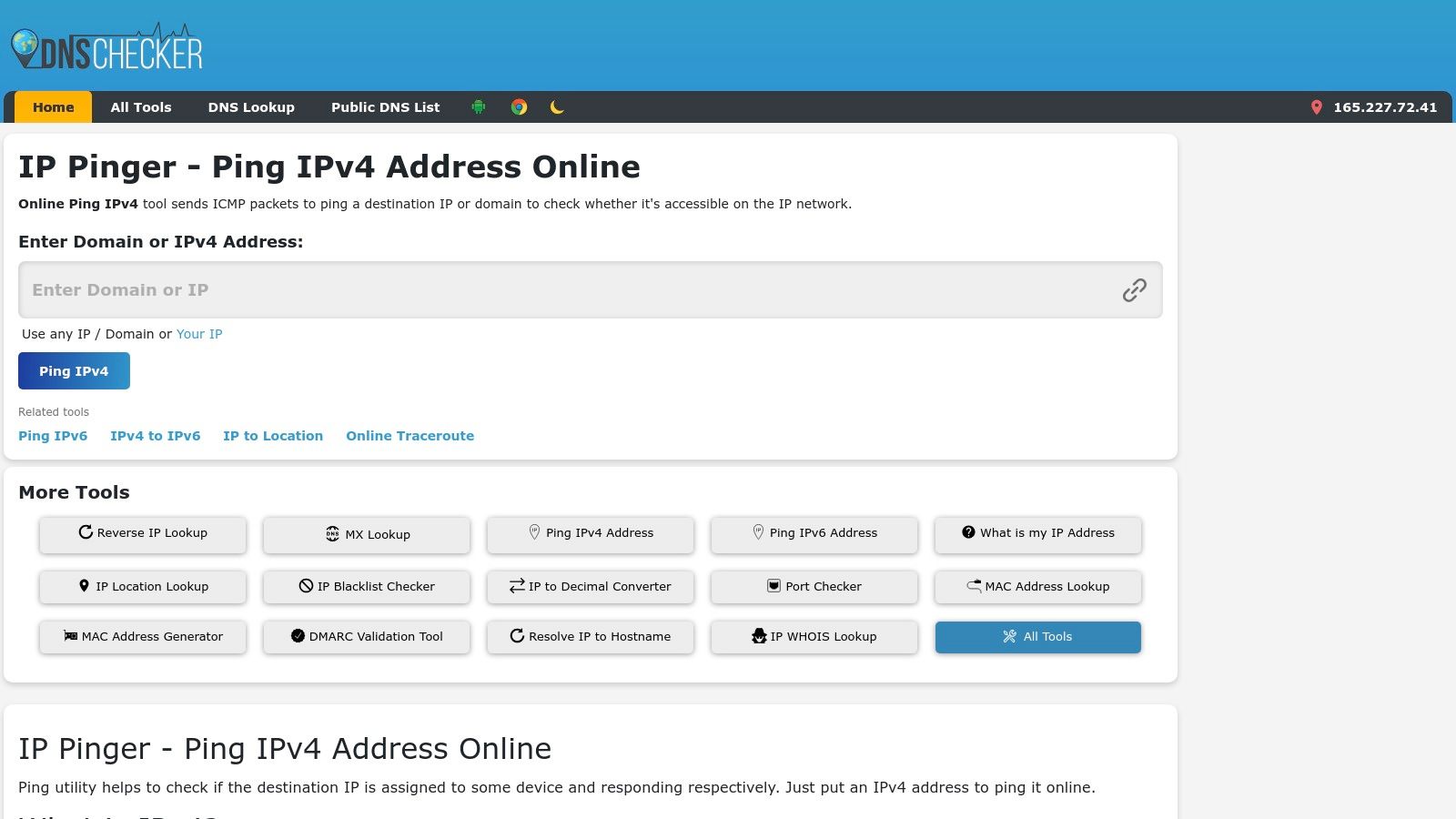
This tool is exceptionally useful for webmasters and developers who need to quickly determine if a site is down for everyone or just them. The user-friendly interface requires no software installation; you simply enter the target and get instant results. It’s a purely functional tool for troubleshooting rather than for SEO indexing signals.
To use the tool, navigate to the page, enter the IPv4 address or domain name you wish to test, and click the "Ping" button. The results will show you the time it takes for packets to travel to the server and back, which is essential for identifying latency or connectivity problems.
Our Take: This tool serves a different but vital purpose. Its primary limitation is the lack of IPv6 support and its focus on technical pings, not search engine notification. It won't help with content indexing but is invaluable for basic server health checks. Monitoring uptime is crucial, as it directly impacts how search engines crawl and rank your site; you can explore how to check Bing rankings to understand the full picture of search visibility.
Website: https://dnschecker.org/ping-ipv4.php
While many tools on this list focus on notifying search engines, BroadbandSearch.net’s Online Ping Tool serves a different but equally crucial purpose: network diagnostics. This utility is not for content indexing but for verifying server uptime and measuring connectivity performance. Its primary function is to send multiple data packets to a specified domain or IP address to determine if it's online and how quickly it responds. This makes it a go-to for troubleshooting website availability or network latency issues from an external perspective.
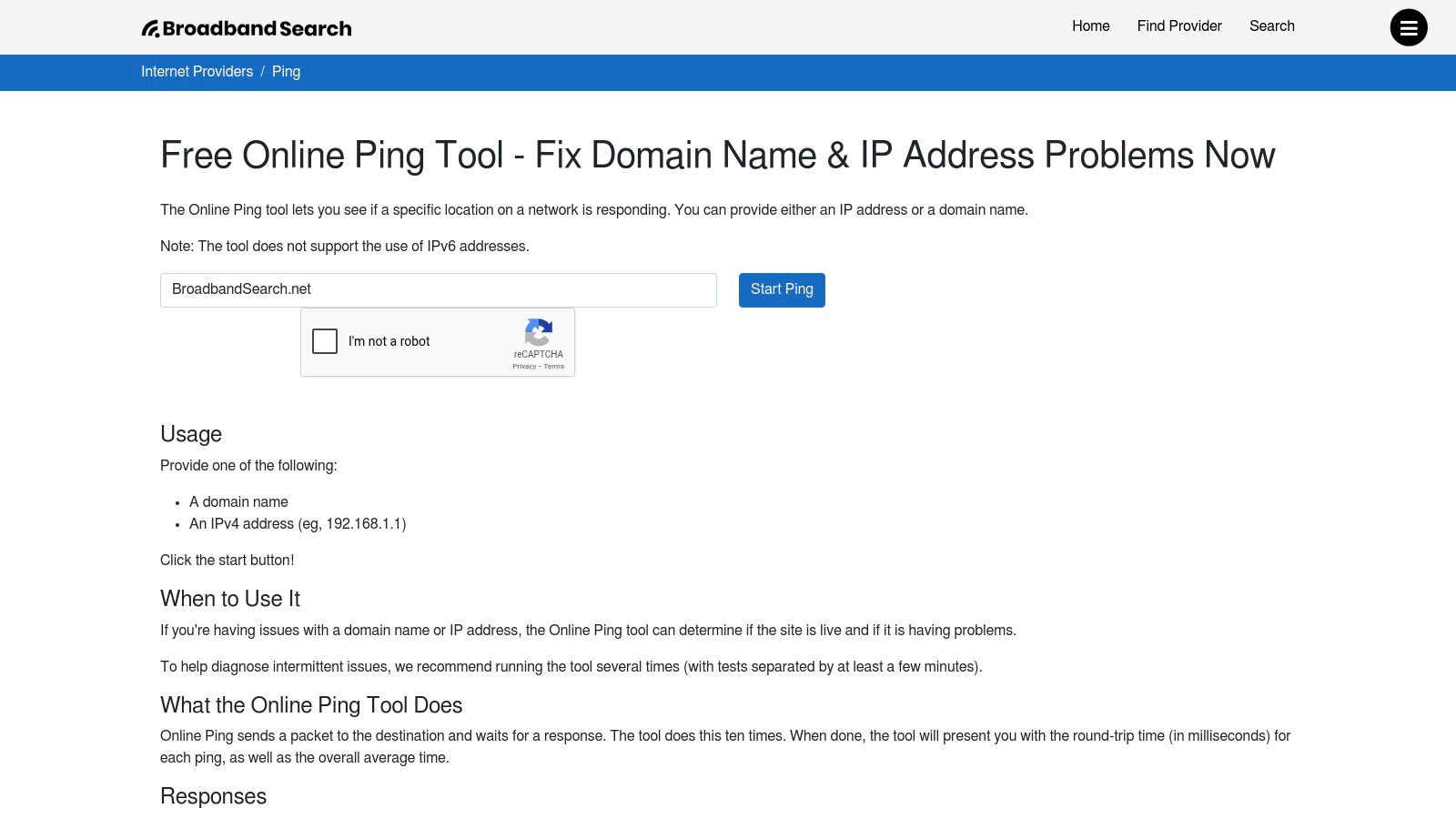
The platform’s strength is its simplicity and focus. It provides a clear, immediate answer to the question, "Is my website reachable?" By sending several packets, it can also help diagnose intermittent connectivity problems, showing packet loss and the average round-trip time. This free pinging service requires no setup or technical expertise, offering a straightforward web interface for quick checks.
This tool is best used for instant diagnostic checks. Simply enter your website's domain or IP address and click "Ping." The results will show you the latency from the tool's server to yours, which is valuable for confirming if a site outage is local to you or a more widespread problem.
Our Take: This is a diagnostic utility, not a search engine indexing tool. It excels at its narrow function: providing a quick, external perspective on your server's responsiveness. While it won't help get your new blog post indexed, it's an indispensable resource for any webmaster who needs to quickly check if their site is down or experiencing performance lags. Its limitation is its very focus; it does nothing beyond a basic ping test.
Website: https://www.broadbandsearch.net/ping
Tools I Seek provides a straightforward and highly accessible free pinging service designed for rapid content indexing. Its main appeal lies in its simplicity, offering a no-frills interface that allows users to quickly notify major search engines and blog directories about new or updated URLs. This tool is perfect for webmasters who need a quick, one-off solution without the complexity of installing software or scripts.
The platform streamlines the process into a few simple steps: enter your blog name, URL, and RSS feed URL, then click submit. It handles the backend work of sending out pings to a curated list of services, aiming to accelerate the discovery of your content. While it lacks advanced features like automation or analytics, its directness is its core strength.
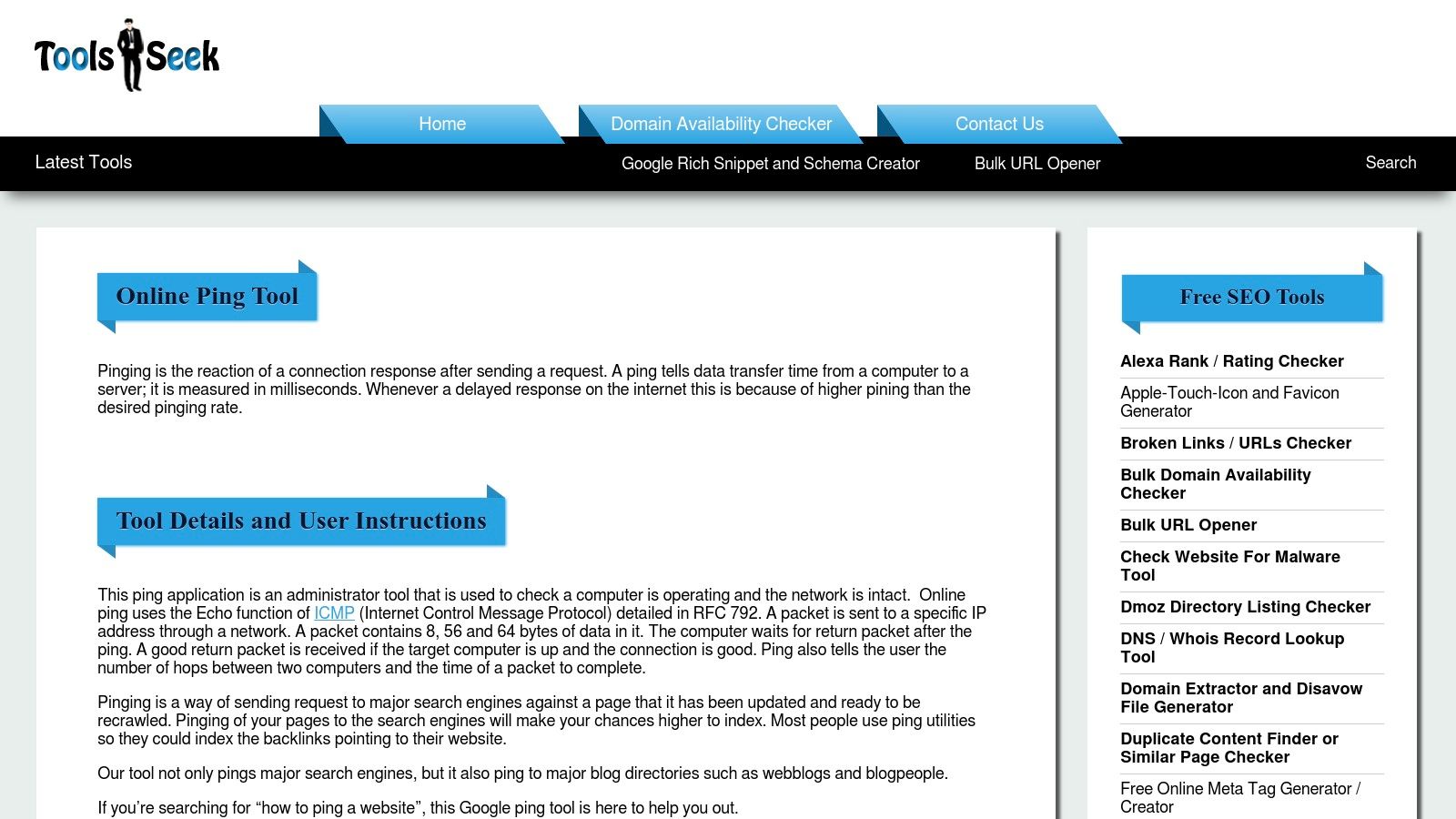
For optimal results, use this tool immediately after publishing a new blog post or making significant updates to a page. Because it is a manual service, it is best integrated into your content publishing checklist. Simply bookmark the page and make it a final step before you move on to your next task.
Our Take: This is a classic, utility-focused tool. It does one thing and does it well without requiring any registration or technical setup. The primary limitation is its manual nature, which makes it less suitable for sites that publish content at a high frequency. For bloggers or small businesses needing a quick indexing boost for a specific page, this is an excellent, hassle-free option that delivers on its promise.
Website: https://toolsiseek.com/online-ping-tool/
SmallSEOTools provides one of the most recognized suites of free SEO utilities, and its Online Ping Website Tool is a staple for many webmasters. This free pinging service offers a no-frills, straightforward method to notify a broad range of search engines and blog directories about new or updated content on your site. Its main draw is its simplicity and integration within a wider ecosystem of familiar tools.
The platform is entirely web-based and requires no registration, making it ideal for quick, one-off pings. You simply enter your blog/website URL, its title, and select a relevant category to provide context. The tool then sends out notifications to dozens of services simultaneously, helping to accelerate the discovery process for your latest posts or page changes.
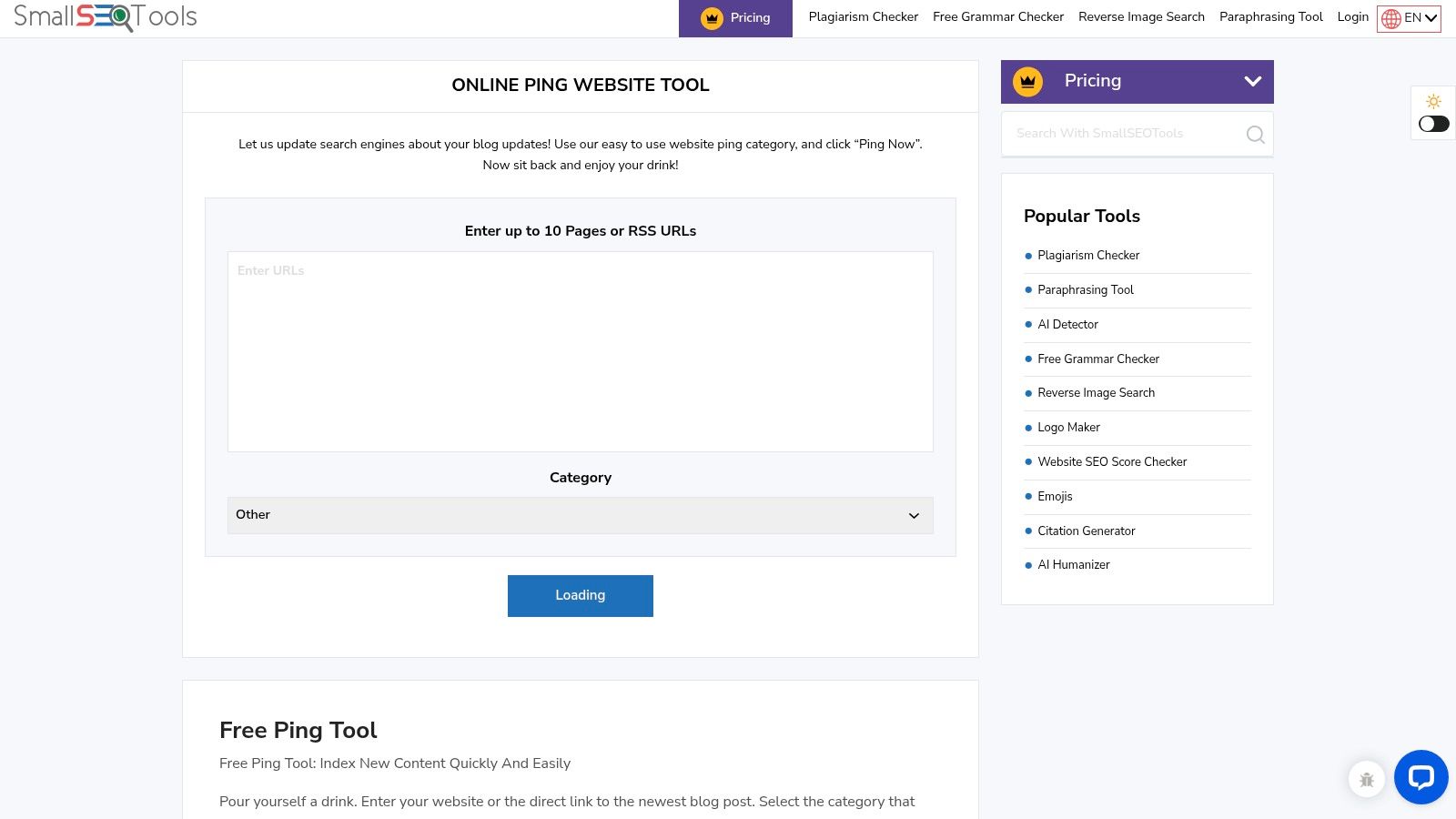
For best results, use this tool immediately after publishing a significant new piece of content or making substantial updates to an existing page. To begin, navigate to the tool, input your main blog URL (or the specific new page URL), provide a concise title, and choose the most fitting category from the dropdown menu. Clicking "Ping Now" initiates the process, and you'll see a log of which services successfully received the notification.
Our Take: This tool is a reliable workhorse for manual pinging, but its effectiveness can be hampered by the prominent ads, which may require you to disable ad-blockers. While it's great for accessibility and ease of use, it lacks automation and advanced features. It’s a foundational part of a broader SEO strategy; you can explore the fundamentals by learning about advanced technical SEO topics.
Website: https://smallseotools.com/online-ping-website-tool/
IP Address Guide offers a no-frills, web-based tool designed for pure network diagnostics rather than SEO-focused content pinging. This free pinging service excels at one specific task: sending ICMP packets to a server or domain to verify its online status and measure network latency. Its primary function is to help system administrators, developers, and network technicians quickly check if a host is reachable across the internet.
The tool is straightforward, providing essential round-trip time measurements without the complexity of command-line interfaces. While it doesn't submit URLs to search engines, its value lies in its ability to troubleshoot connectivity issues that could indirectly impact SEO, such as confirming that your server is responding promptly or is even online at all.
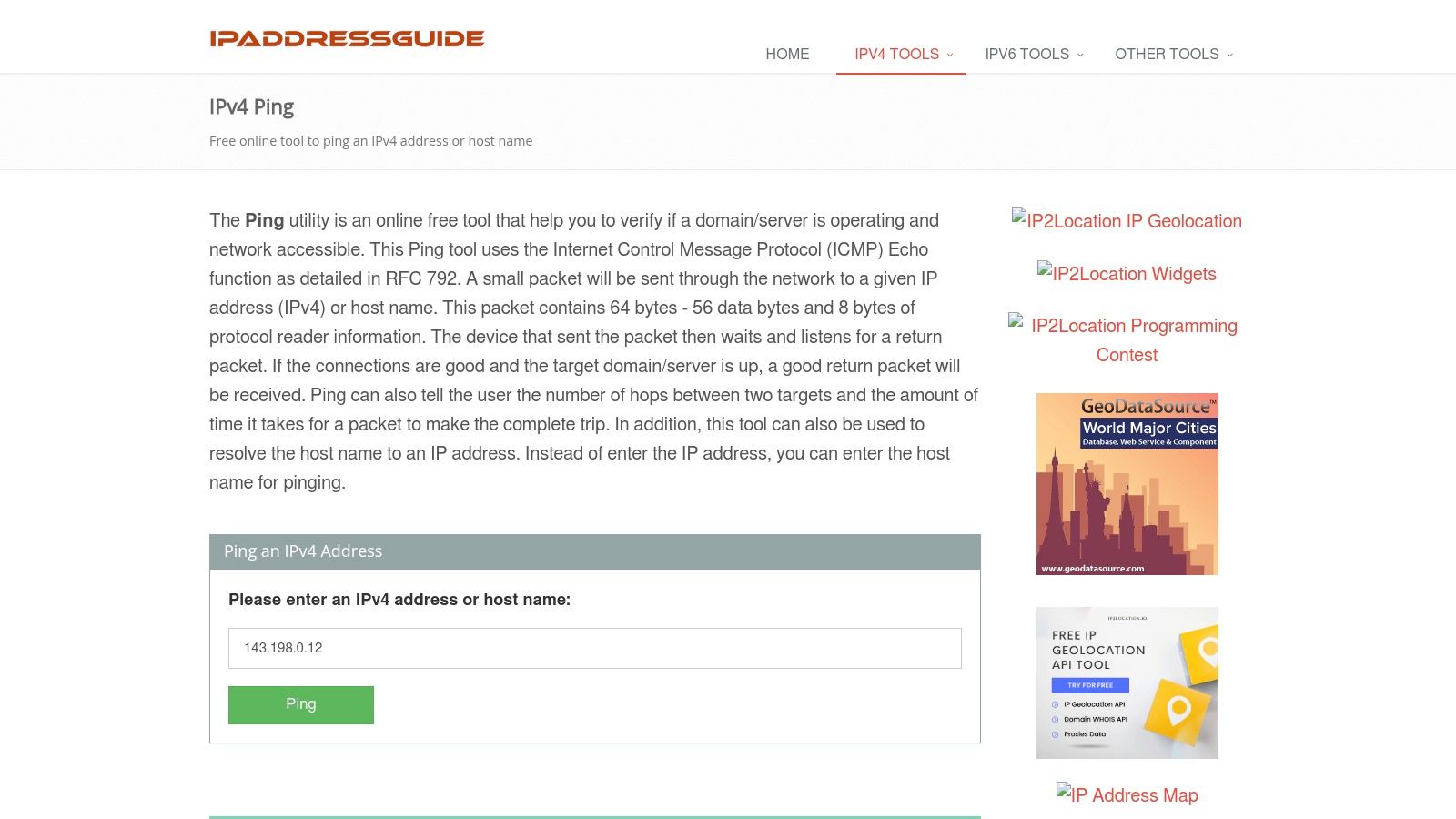
Using this utility is incredibly simple. You just enter a domain name or an IPv4 address into the designated field and click the "Ping" button. The results will show whether the ping was successful and display the time it took for the packets to travel to the server and back, offering a quick health check on your server's responsiveness.
Our Take: This is not a content indexing tool, but a technical utility. It’s perfect for a quick server health check or diagnosing why your site might be inaccessible. Its limitation is its strength: it does one thing and does it well. If you need to troubleshoot basic network connectivity without opening a terminal, this is an excellent resource. For those more interested in getting content discovered by search engines, a dedicated content indexing service would be the appropriate choice.
Website: https://www.ipaddressguide.com/ping
HostingChecker offers a diagnostic tool that shifts the focus from indexing to network performance. While not a traditional content pinging service, its IP/URL Ping Tool is invaluable for diagnosing site accessibility and speed, which are critical factors for SEO and user experience. This free pinging service tests your website's response time from over 10 global server locations simultaneously, providing a clear picture of its worldwide performance.
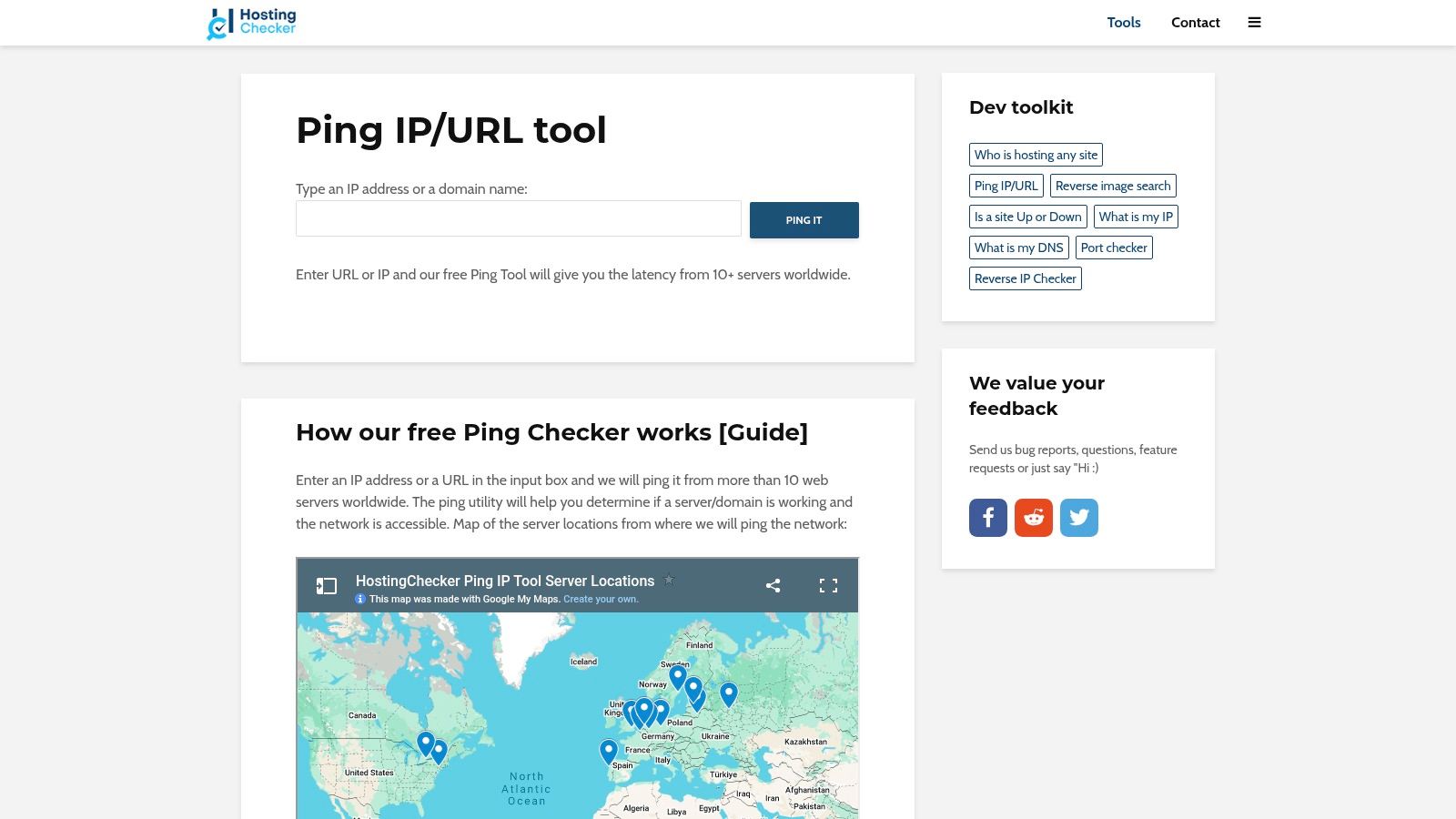
The platform presents results in a simple, color-coded table showing minimum, maximum, and average latency from each location. This makes it easy to spot regional connectivity problems or issues with your Content Delivery Network (CDN) configuration. For webmasters troubleshooting slow load times for international visitors, this tool offers immediate, actionable insights without requiring any technical setup or registration.
Using the tool is as simple as entering your domain or IP address and clicking "Check." To get the most value, run tests before and after making server or CDN changes to quantify the performance impact. Regularly checking your main domain and key subdomains can help you proactively identify and resolve regional latency issues before they affect your search engine rankings or user satisfaction.
Our Take: This tool is a diagnostic utility, not an indexing one. Its strength lies in providing a global performance snapshot, making it perfect for identifying high-latency regions that could be hurting your international SEO. While it won't get your new blog post indexed, it will tell you if search engine bots and users in specific countries are struggling to connect to your site, which is an equally important part of the technical SEO puzzle.
Website: https://hostingchecker.com/v1/tools/ping/
Ping.in stands out for its direct and uncluttered approach to content notification. As a completely free pinging service, it provides a streamlined way for webmasters and bloggers to inform various search engines and directories about new or updated content. Its core strength is its simplicity, removing complex configurations and focusing purely on the act of mass-pinging from a single interface.
The platform is designed for quick, one-off submissions. You enter your blog's URL, a title for the post, and select relevant categories to help target the submission. This category-based system is a unique feature that aims to send pings to more niche-specific services, potentially increasing the relevance of the signal and aiding discovery.
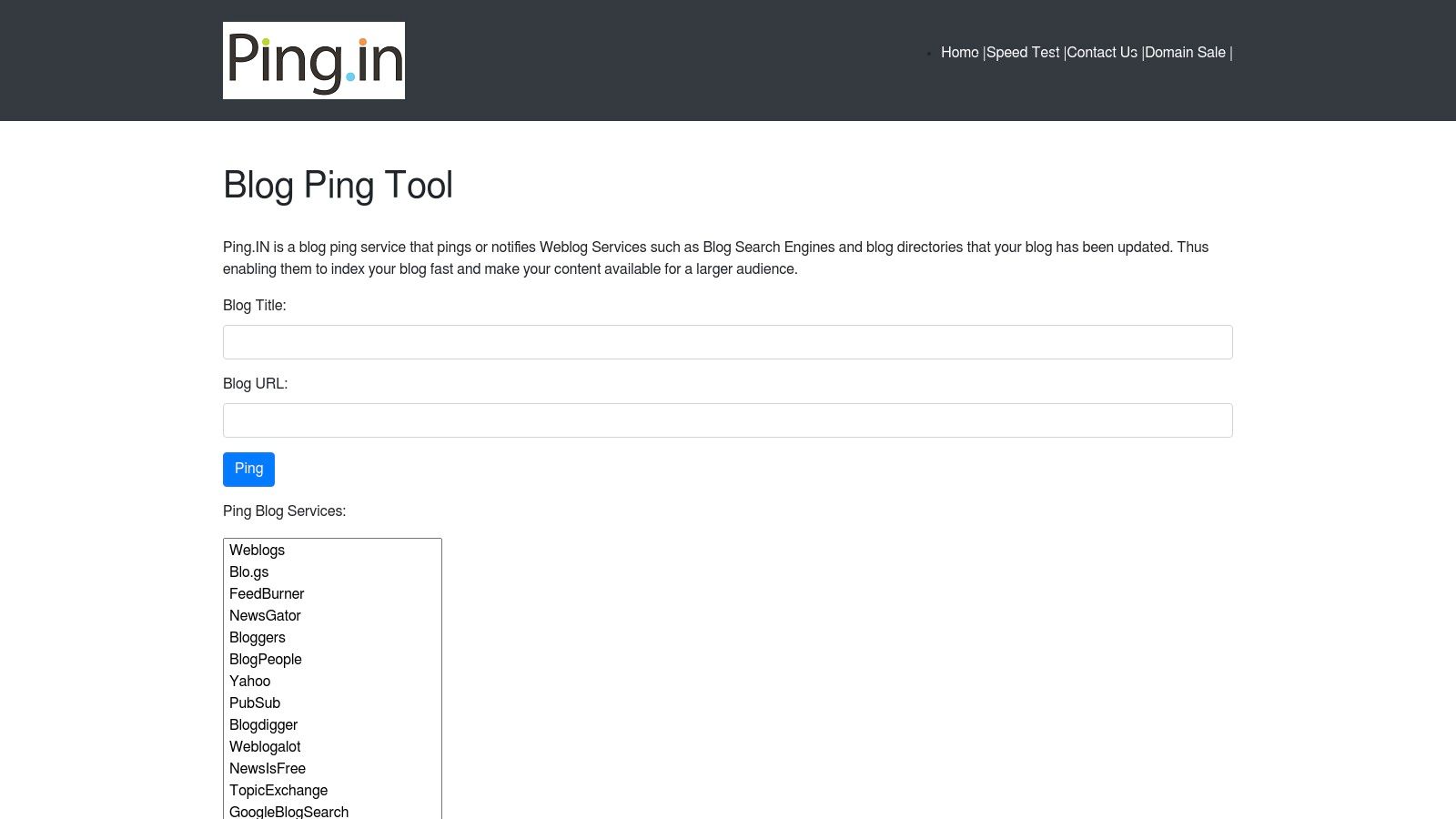
To maximize Ping.in’s utility, use it immediately after publishing a new blog post or making significant updates to an important page. Fill in your URL, the post title, and carefully select the most relevant categories from the checklist provided. This ensures your ping is dispatched to a curated list of services that align with your content’s topic, from tech to business.
Our Take: The most significant limitation is that it only processes one URL at a time, making it impractical for bulk submissions or site-wide updates. However, for a quick and targeted ping after publishing a single article, its simplicity is its greatest asset. The interface is user-friendly, making it an excellent tool for beginners or anyone needing a no-fuss, manual pinging solution.
Website: https://ping.in
Navigating the landscape of free pinging services reveals a spectrum of tools, each with its distinct purpose and ideal user. We've explored everything from basic network diagnostic tools like the IPAddress.com Ping Test to more SEO-focused solutions such as SmallSEOTools' Online Ping Website Tool. The key takeaway is that not all pinging tools are created equal, and the "best" service is entirely dependent on your specific objective.
The journey from a simple ping to strategic indexing is a critical one for any digital professional. While a traditional ping is excellent for a quick server health check, its direct impact on modern search engine indexing is minimal. Search engines have evolved far beyond the simple ping signal, now relying on sophisticated crawlers, sitemaps, and direct API integrations.
Selecting the appropriate tool requires a clear understanding of your goal. Before you choose a free pinging service, ask yourself these crucial questions:
The ultimate goal for most marketers, bloggers, and business owners isn't just to send a signal; it's to get content seen, crawled, and ranked by search engines. Relying solely on a traditional free pinging service for this purpose is an outdated strategy. Modern SEO demands a more direct and reliable method to communicate with search engines.
This means prioritizing actions that have a proven impact:
The tools we've covered serve as a valuable starting point, especially for network diagnostics and basic update signals. However, for those serious about accelerating their content's journey into search engine results, it's time to graduate from simple pings to intelligent, API-driven indexing solutions. This strategic shift ensures your valuable content doesn't just send a signal into the void but gets the attention it deserves.
Tired of waiting for Google to notice your new content? While a free pinging service can send a basic signal, IndexPilot uses Google's official Indexing API to submit your URLs directly, often resulting in indexing within hours, not weeks. Take control of your SEO and ensure your pages get discovered faster by trying IndexPilot today.